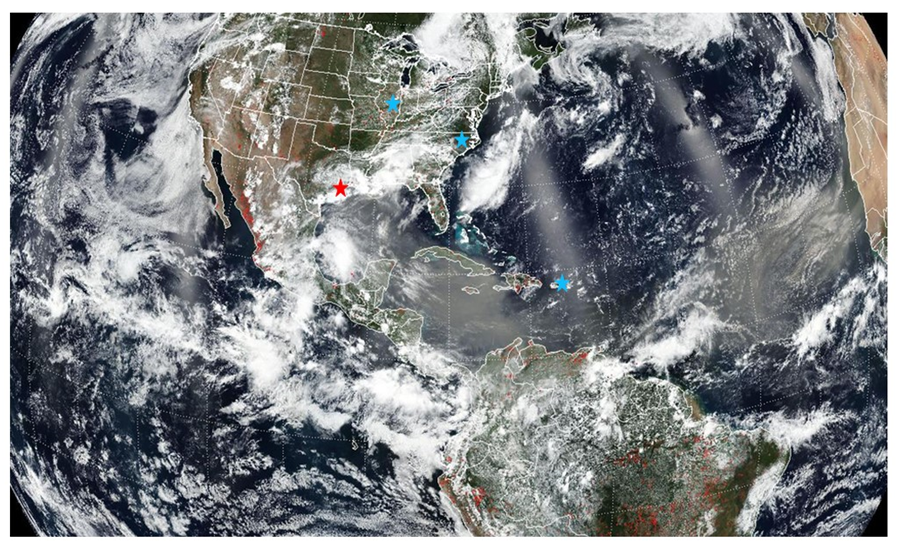ENV Professors Investigate the Atmospheric Effects of June 2020 ‘Godzilla Dust Storm’
Every year dust from the Saharan desert is transported across the Atlantic Ocean to North America. These dust events can affect air quality, climate, weather and both land and water-based ecosystems. Models suggest that the frequency and intensity of these Saharan dust events will increase in the future due to changes in land use and weather patterns. This makes it critical to identify the occurrence and understand the impact of these dust events.
In June 2020 there was an especially large dust event - so big that it was called the 'Godzilla dust storm' in some media reports. The dust from this storm was observed as far north as Michigan and as far west as Texas and was especially intense in Puerto Rico and other parts of the Caribbean. It caused air quality and visibility degradation and, as shown in this new paper, had other impacts as well. Satellite images (see figure) showed the widespread presence of dust across the much of the US. We used surface-based measurements of atmospheric particles from two NOAA Federated Aerosol Network monitoring sites (one in Illinois and one in North Carolina) as well as a Texas Commission on Environmental Quality site near Houston to identify the presence of the Saharan dust. The particle properties during the dust event were clearly different from the properties of the atmospheric particles normally sampled at each of these sites. However, the changes in the properties during the dust event were also different at each site likely due to changes during transport and the background characteristics at each location. This is important in terms of understanding human exposure to the dust and also how the presence of long-range transported dust might cause locations to be out of compliance with federal air quality regulations.
In addition to changing the number and type of particles in the atmosphere, the dust particles scatter and absorb sunlight which has implications for climate. We used a model to determine how the presence of dust changed the temperature profile of the atmosphere. The model suggested, enhanced scattering and absorbing of sunlight reduced the amount of solar energy reaching the surface in the presence of Saharan dust compared to when it was not. In addition, this interaction of sunlight with dust in atmosphere resulted in warming of the air. This sort of atmospheric heating is one of the factors that control the strength of temperature inversions which trap pollutants close to the surface. Atmospheric heating can also impact cloud formation and how long clouds last as well as weather patterns driven by temperature differences (see Figure below). Future studies should consider both surface effects to improve the accuracy of air quality forecasts and how dust interacts with sunlight to improve weather forecasts and climate change predictions. This work was published in Atmospheric Environment https://doi.org/10.1016/j.atmosenv.2023.119988 in a combined effort from Baylor University, University of Houston, Greenhood Nepal, CIRES – University of Colorado – Boulder, NOAA and Appalachian State University.
This project represents the combined efforts of a large contingent of Baylor students and faculty, including three Environmental Science faculty members (Rebecca Sheesley, Sascha Usenko, and Melinda Coogan), a post-doctoral scholar (Manisha Mehra), and five graduate students (Sujan Shrestha, Krishnakumar AP, Meghan Guagenti, Claire E. Moffett, and Sarah Guberman VerPloeg). Sic em Bears!

